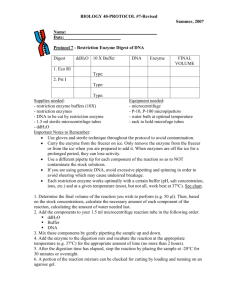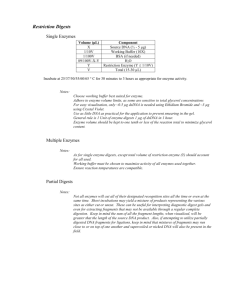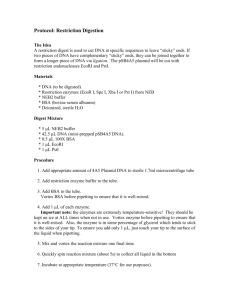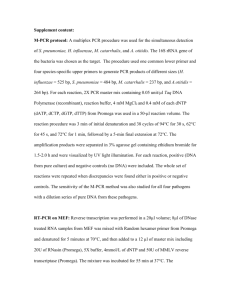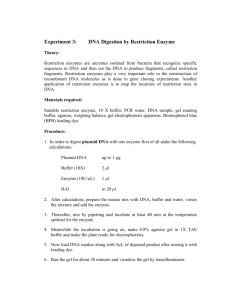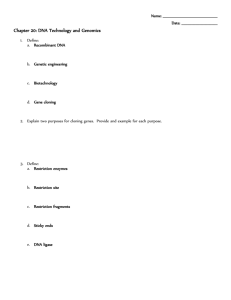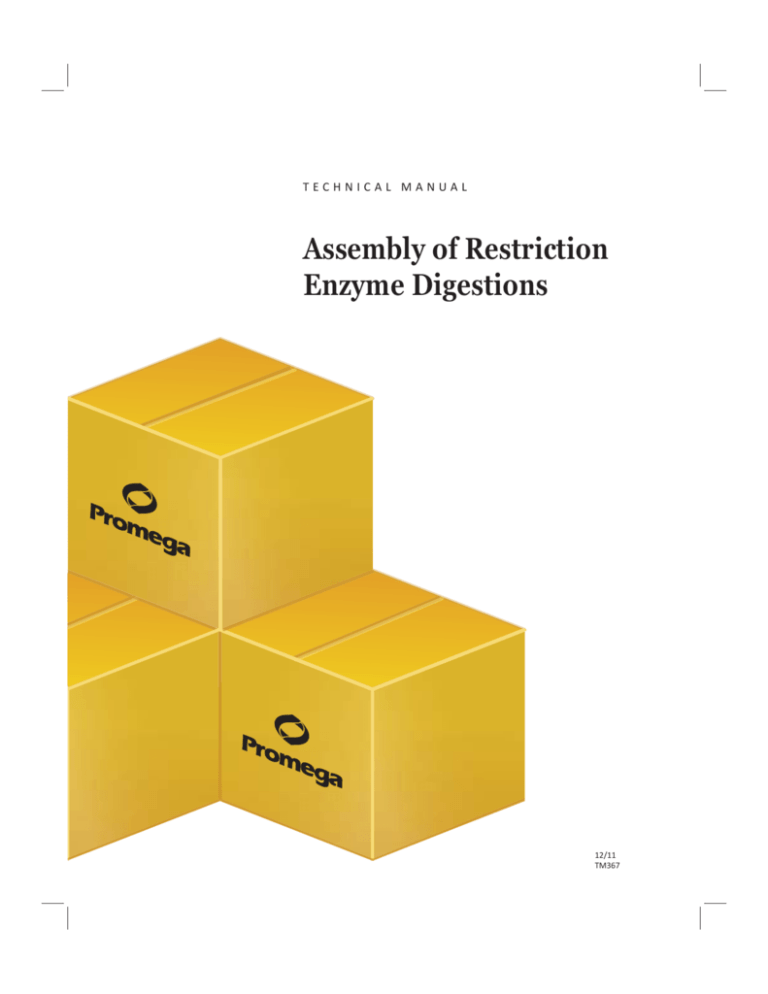
TECHNICAL MANUAL
Assembly of Restriction
Enzyme Digestions
12/11
TM367
Assembly of Restriction
Enzyme Digestions
All technical literature is available at: www.promega.com/protocols/
Visit the web site to verify that you are using the most current version of this Technical Manual.
E-mail Promega Technical Services if you have questions on use of this system: techserv@promega.com
1. Description......................................................................................................................................... 1
2. DNA Substrate Considerations ............................................................................................................. 2
3. Enzyme Storage, Handling and Use ...................................................................................................... 3
4. Setting up a Restriction Enzyme Digestion ............................................................................................ 3
5. Experimental Controls......................................................................................................................... 3
6. Additional Protocols for Selected Restriction Enzymes ........................................................................... 4
6.A. Protocol for Rapid Digestion of Plasmid DNA ............................................................................... 5
6.B. Protocol for Direct Digestion of PCR or RT-PCR Products in GoTaq® Green Master Mix or
PCR Master Mix ......................................................................................................................... 5
7. References .......................................................................................................................................... 6
1.
Description
Restriction enzymes, also referred to as restriction endonucleases, are enzymes that recognize short, specific (often
palindromic) DNA sequences. They cleave double-stranded DNA (dsDNA) at specific sites within or adjacent to their
recognition sequences. Most restriction enzymes (REs) will not cut DNA that is methylated on one or both strands of
their recognition site, although some require substrate methylation.
Each restriction enzyme has specific requirements for optimal activity. Ideal storage and assay conditions favor the
highest enzyme activity and fidelity. Conditions such as temperature, pH, enzyme cofactor(s), salt composition and
ionic strength affect enzyme activity and stability. Two reaction buffers usually accompany each Promega restriction
enzyme: The optimal reaction buffer, which is from the 4-CORE® Buffer System (Reaction Buffers A, B, C and D) or is
one of the other optimal buffers (Reaction Buffers E–L), and MULTI-CORE™ Buffer. The optimal buffer yields 100%
activity for the enzyme it accompanies and serves as the specific reaction buffer for individual digests with that enzyme.
The MULTI-CORE™ Buffer, which is designed for broad compatibility with many REs, is provided with enzymes that
have 25% or greater activity in this buffer. The MULTI-CORE™ Buffer is useful for digestions with multiple REs
because it generally yields higher activity for more enzyme combinations than any other buffer but sometimes results
in a compromise in activity. Digests using multiple REs with significantly different buffer requirements may require
sequential reactions, with addition of RE buffer or salt before the second enzyme is used.
Promega CorporaƟon · 2800 Woods Hollow Road · Madison, WI 53711-5399 USA · Toll Free in USA 800-356-9526 · 608-274-4330 · Fax 608-277-2516
www.promega.com
TM367 · 12/11
1
More information on restriction enzyme compatibilities and buffers for double-digests is available in the
Restriction Enzyme Resource at: www.promega.com/guides/, and in the Promega iPhone/iPad App,
available on the App Store.
2.
DNA Substrate Considerations
Common DNA substrates for restriction enzymes include bacteriophage lambda DNA, bacterial plasmid DNA and
genomic DNA. Lambda DNA is a linear DNA that is an industry standard for measuring and expressing unit activity for
many restriction enzymes. Intact supercoiled plasmid DNA and DNAs with a large number of the target restriction site
require more units of enzyme (two- to tenfold) per microgram than linear DNA if a linear DNA substrate was used in
the enzyme activity assay.
PCR Products and Oligonucleotides are relatively small compared to the DNA substrate used in the unit definition.
Therefore, when using PCR products and oligonucleotides in a restriction digest, it is essential to consider the molar
concentration of enzyme recognition sites and not only the DNA mass. Also, some REs require flanking bases surrounding the core recognition site. This can be a problem when cutting an oligonucleotide or DNA fragment where the
recognition site is near the end. When PCR cloning strategies include the use of PCR primers containing an RE site,
the primer should be designed with adequate DNA surrounding the core recognition sequence. See the Technical
References section at: www.promega.com/resources/ for information on the ability of specific restriction enzymes
to cut PCR products that have restriction sites near the end of the fragment.
DNA Purity is another factor that must be considered. Depending on the purification method and the care taken
during handling, the DNA may contain varying amounts of contaminants that affect restriction enzyme digestion.
Contaminants may include other types of DNA, nucleases, salts and inhibitors of restriction enzymes. The effect of a
contaminant on an RE digest is generally dose-dependent (i.e., inhibitory effects increase with increasing volumes of
DNA added to the reaction). Relatively pure DNA is required for efficient restriction enzyme digestion. Contaminating
nucleases are usually activated only after the addition of salts (e.g., restriction enzyme buffer) to the DNA. Therefore,
appropriate control reactions should always be run in parallel with the restriction enzyme digest (see Section 5).
Buffers containing low concentrations of EDTA (1mM) are often used to protect DNA from nuclease degradation
during storage, but EDTA can interfere with restriction enzyme digestion if the final concentration in the reaction is too
high. This situation usually occurs when the DNA substrate concentration is low, making it necessary to use a large
volume of DNA in the digest. In such cases, it is best to concentrate the DNA (e.g., by ethanol precipitation). Organic
solvents, salts, detergents and chelating agents that are sometimes used during DNA purification also can interfere with
restriction enzyme activity if they carry over into the final DNA solution. Dialysis or ethanol precipitation with 2.5M
ammonium acetate (final concentration before adding ethanol) followed by drying and resuspension can remove many
of these substances. Relatively pure DNA is required for efficient restriction enzyme digestion; however, addition of
acetylated BSA to a final concentration of 0.1mg/ml can improve the efficiency of restriction enzyme digestion of
impure DNA. We recommend that BSA be included in all digests.
2
Promega CorporaƟon · 2800 Woods Hollow Road · Madison, WI 53711-5399 USA · Toll Free in USA 800-356-9526 · 608-274-4330 · Fax 608-277-2516
TM367 · 12/11
www.promega.com
3.
Enzyme Storage, Handling and Use
Maintain the sterility of reagents used in the RE digestion as well as any tools (e.g., tubes and pipette tips) used with
those reagents. Restriction enzymes should be stored in a nonfrost-free freezer except for a brief period during use,
when they should be kept on ice. The restriction enzyme is usually the last component added to a reaction to ensure
that it is not exposed to extreme conditions. When many similar digests are being prepared, it may be convenient to
create premixes of common reagents.
Before assembling the restriction enzyme digestion, thoroughly mix each component, then centrifuge briefly to collect
contents at the bottom of the tube. The assembled reaction should be mixed after enzyme addition. Mix all solutions
containing restriction enzymes gently to avoid enzyme inactivation.
4.
Setting up a Restriction Enzyme Digestion
An analytical-scale restriction enzyme digestion is usually performed in a volume of 20μl with 0.2–1.5μg of substrate
DNA and a two- to tenfold excess of enzyme. If an unusually large volume of DNA or enzyme is used, aberrant results
may occur. The following protocol is an example of a typical RE digestion.
1.
In a sterile tube, assemble the following components in the order listed below.
Component
Sterile, deionized water
Restriction Enzyme 10X Buffer
Volume
16.3µl
2µl
Acetylated BSA, 10µg/µl
0.2µl
DNA, 1µg/µl
1.0µl
Mix by pipetting, then add:
Restriction Enzyme, 10u/µl
0.5µl
Final volume
20µl
2.
Mix gently by pipetting, close the tube and centrifuge for a few seconds in a microcentrifuge. Incubate at the
enzyme’s optimum temperature for 1–4 hours.
3.
Add loading buffer to a 1X final concentration and proceed to gel analysis.
Note: Overnight digestions are usually unnecessary and may result in DNA degradation.
5.
Experimental Controls
Experimental controls are necessary to identify, understand and explain problems or inconsistencies in results. The
following controls are commonly used in parallel with RE digests: (1) uncut experimental DNA, (2) digestion of a
commercially supplied control DNA and (3) no-enzyme “mock” digestion. We also recommend analyzing one or
two different size markers in more than one lane per gel (i.e., different locations on the gel).
Promega CorporaƟon · 2800 Woods Hollow Road · Madison, WI 53711-5399 USA · Toll Free in USA 800-356-9526 · 608-274-4330 · Fax 608-277-2516
www.promega.com
TM367 · 12/11
3
6.
Additional Protocols for Selected Restriction Enzymes
Promega scientists have tested a subset of restriction enzymes for compatibility with rapid digestion (digesting DNA in
15 minutes or less) and direct digestion in GoTaq® Green Master Mix or PCR Master Mix (1,2). The results are shown
in Table 1.
A protocol for rapid digestion is provided in Section 6.A, and a protocol for direct digestion of a PCR product is
provided in Section 6.B.
Table 1. Compatibility of Restriction Enzymes With Rapid Digestion or Direct Digestion.
Rapid-DigestCapable
GoTaq® BufferCompatible
Rapid-DigestCapable
GoTaq® BufferCompatible
AatII
+
—
KpnI
+
+
Acc65I
nt
AccI
nt
+
MluI
nt
+
+
NcoI
+
+
AgeI
+
+
NdeI
+
+
AluI
+
nt
NheI
+
+
ApaI
nt
+
NotI
+
nt
AvaI
nt
+
NsiI
nt
+
BamHI
+
+
PstI
+
+
BglII
—
+
PvuI
—
+
ClaI
+
+
PvuII
+
+
DdeI
+
nt
RsaI
+
nt
DpnI
+
nt
SacII
—
+
DraI
nt
+
SalI
+
+
Eco47III
nt
+
ScaI
+
—
EcoRI
+
—
SpeI
+
nt
EcoRV
+
+
SphI
+
+
HaeIII
+
nt
StuI
nt
+
HincII
nt
+
XbaI
+
+
HindIII
+
+
XhoI
+
+
HpaI
nt
+
XmaI
+
nt
Restriction
Enzyme
Restriction
Enzyme
nt = Not Tested; + indicates successful cutting in 15 minutes or less; — indicates unsuccessful cutting. Data and
additional information are available in References 1 and 2.
4
Promega CorporaƟon · 2800 Woods Hollow Road · Madison, WI 53711-5399 USA · Toll Free in USA 800-356-9526 · 608-274-4330 · Fax 608-277-2516
TM367 · 12/11
www.promega.com
6.A. Protocol for Rapid Digestion of Plasmid DNA
1.
To perform a rapid digestion, assemble the following components on ice in 0.5ml tubes in the order listed:
Component
Volume
Sterile, deionized, nuclease-free water
Restriction Enzyme 10X Buffer
Acetylated BSA, 10µg/µl
Plasmid DNA, 1µg/µl
15.8µl
2µl
0.2µl
1µl
Mix by pipetting, then add:
Restriction enzyme1
Final volume
1µl
20µl
1
The number of restriction enzyme units added to the reaction varies at 5–12 units, depending
on the concentration of restriction enzyme used.
2.
Mix gently by pipetting, close the tube and centrifuge for a few seconds at maximum speed in a microcentrifuge.
Incubate at the enzyme’s optimum temperature for 5–15 minutes.
6.B. Protocol for Direct Digestion of PCR or RT-PCR Products in GoTaq® Green Master Mix or
PCR Master Mix
The restriction enzymes listed in Table 1 were tested for direct digestion in GoTaq® Green Master Mix or PCR Master
Mix using 25µl reactions and a final master mix concentration of 1X.
Note: Even after thermal cycling is complete, the thermostable DNA polymerase retains some activity, which could fill
in the sticky ends generated during a subsequent RE digestion. These blunt-ended products can result in reduced
cloning efficiency. While adding a restriction enzyme directly to the PCR saves time, purifying the DNA product after
digestion might be advantageous to remove small restriction fragments that could interfere with downstream ligation.
1.
To perform restriction enzyme digestion, assemble the following components on ice in 0.5ml tubes in the order
listed:
Component
Volume
Unpurified PCR product
1
Restriction enzyme
Final volume
25µl
0.5µl
25.5µl
1
The number of restriction enzyme units added to the reaction varies at 1–6 units, depending
on the concentration of restriction enzyme used.
2.
Mix gently by pipetting, close the tube and centrifuge for a few seconds in a microcentrifuge. Incubate at the
enzyme’s optimum temperature for 2 hours.
Promega CorporaƟon · 2800 Woods Hollow Road · Madison, WI 53711-5399 USA · Toll Free in USA 800-356-9526 · 608-274-4330 · Fax 608-277-2516
www.promega.com
TM367 · 12/11
5
7.
References
1.
Schagat, T. (2007) Rapid DNA digestion using Promega restriction enzymes. Promega Corporation Web site:
www.promega.com/resources/articles/pubhub/enotes/rapid-dna-digestion-using-promegarestriction-enzymes/
2.
Tritle, D. (2006) Activity of Promega restriction enzymes in GoTaq® Green and PCR Master Mixes. Promega
Corporation Web site:
www.promega.com/resources/articles/pubhub/enotes/activity-of-promega-restriction-enzymesin-gotaq-green-and-pcr-master-mixes/
© 2011 Promega CorporaƟon. All Rights Reserved.
4-CORE and GoTaq are registered trademarks of Promega CorporaƟon MULTI-CORE is a trademark of Promega CorporaƟon.
Products may be covered by pending or issued patents or may have certain limitaƟons. Please visit our Web site for more informaƟon.
All prices and specificaƟons are subject to change without prior noƟce.
Product claims are subject to change. Please contact Promega Technical Services or access the Promega online catalog for the most up-to-date
informaƟon on Promega products.
6
Promega CorporaƟon · 2800 Woods Hollow Road · Madison, WI 53711-5399 USA · Toll Free in USA 800-356-9526 · 608-274-4330 · Fax 608-277-2516
TM367 · 12/11
www.promega.com

